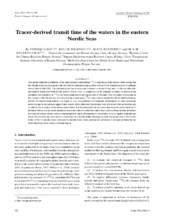Tracer-derived transit time of the waters in the eastern Nordic Seas
Peer reviewed, Journal article
Published version
Permanent lenke
https://hdl.handle.net/1956/790Utgivelsesdato
2005-08-25Metadata
Vis full innførselSamlinger
- Geophysical Institute [1198]
Originalversjon
https://doi.org/10.1111/j.1600-0889.2005.00153.xSammendrag
The spatial-temporal distribution of the anthropogenic radionuclide 137Cs originating from nuclear bomb testing and the Sellafield reprocessing plant in the Irish Sea is simulated using a global version of the Miami Isopycnic Coordinate Ocean Model (MICOM). The physical model has a horizontal resolution of about 40 km, and it is forced with daily atmospheric reanalysed fields for the period 1948 to 2002. A comparison of the temporal evolution of observed and simulated concentrations of 137Cs has been conducted for the regions east of Scotland, west of central Norway and at the entrance of the Barents Sea. It follows that the annual mean 137Cs concentration signal from the Sellafield discharge reaches the southwestern Barents Sea region in 5 yr, in accordance with available observations. To more accurately assess the age of the caesium-tagged water masses, three additional experiments were performed with an Eulerian age coupled to the evolution of the tracer concentration. It is demonstrated that the transit time depends on the duration of the tracer release history, on the dynamical ocean state and on whether the transit time is derived from the time difference between the release history and the concentration evolution downstream of the release, or as an explicit Eulerian age tracer. The Eulerian age tracer gives a transit time for a Sellafield-like discharge to reach the Barents Sea of 56 months in the 1970s, 52 months in the 1960s and 51 months in the 1980s, and that this difference is strongly governed by the ocean dynamics in the Faeroe–Scotland region.
